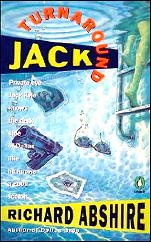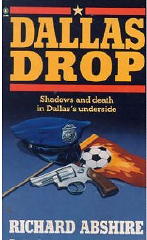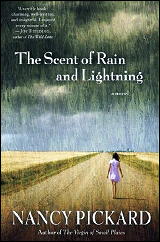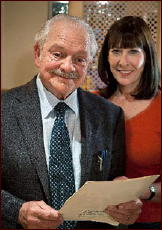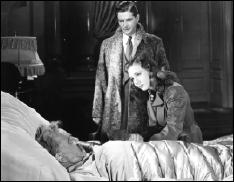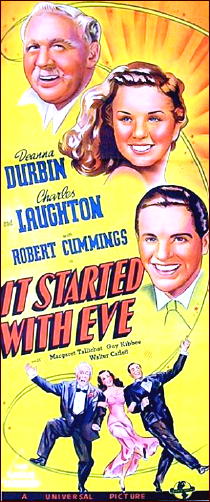Sat 2 Oct 2010
COLLECTING PULPS: A MEMOIR, Part Two – Dime Detective, by Walker Martin.
Posted by Steve under Collecting , Columns , Pulp Fiction[18] Comments
PART TWO — DIME DETECTIVE
by Walker Martin

In 1969 as I was in the process of writing many letters to dealers, collectors, bookstores and so on, in order to locate back issues of Black Mask, I naturally wanted to also collect the main competitor to Black Mask. Dime Detective was one of the early titles put out by the new publisher at the time, Popular Publications. It lasted for 273 issues during the period 1931 through 1953.
At first the new magazine looked like a combination of hardboiled detective, gothic horror, and weird menace fiction. The early issues had examples of these type of stories and I was puzzled to see horror titles like “The Shadow of the Vulture,” “The Devil’s Jackpot,” “The Phantom of the Porthole,” “The Chamber of Doom,” and “Horror House.” But I was relieved to see such favorite Black Mask writers as Frederick Nebel, Erle Stanley Gardner, and even the much maligned Carroll John Daly.
As the main competitor to Black Mask, Dime Detective paid higher than usual pulp rates, even going as high as four cents a word to tempt writers away from the other magazine.
In fact, by 1936 Black Mask was having circulation problems and editor Joseph Shaw even left the magazine in that year over some disagreement concerning money and the direction the magazine was going.

When Shaw left, Raymond Chandler switched to Dime Detective and its higher rates and published seven excellent novelettes during 1937 through 1939. These issues especially go for high prices, and I’ve recently seen copies sell for hundreds of dollars each.
I personally am sure that soon we will see nice copies going for over a thousand. Raymond Chandler, like Hammett, has claim to being among the very best of the pulp writers and in fact both writers are now routinely accepted as part of the great American literary tradition.
However, in 1969 and in the early 1970’s I had very little competition and managed to pick up just about all the issues for only $2.00 or $3.00 each. Even in those days I did not consider these prices a drain on my finances, and most other collectors continued to happily concentrate on SF and the hero pulps.
Instead of letting these guys continue on their wayward ways, I made the mistake of praising the magazine as being an untapped lode of great detective fiction, and before I realized it I had again created my own competition. As I think back on myself 40 years ago, it was almost like I was some sort of mad doctor creating my own Frankenstein monster.
This hideous monster turned out to be other collectors fighting me for Dime Detective and my other favorite pulp titles, that once were fairly unknown until I opened my big mouth.

Speaking of “mad doctors,” author Ron Goulart thought pulp collectors were so strange that he put several of us in novels, including the Avenger series of paperbacks that he wrote in the 1970’s under the Kenneth Robeson name. I appeared as the mad Doctor Walker-Martin in Red Moon (1974). Other collectors to appear in Ron’s novels were Bob Briney, Jack Irwin, Jack Deveny, Bob Weinberg, Bob Sampson, Richard Minter, and even Mystery*File honcho, Steve Lewis, among others.
Fortunately I managed to complete my set of 273 issues within a very short time thanks to Richard Minter’s mail order business and my letter writing scheme which unearthed all sorts of Dime Detective’s for little cost.
I say “unearthed,” and this actually happened when a collector from Ohio discovered stacks of the magazine in a basement of a house about to be demolished. By now in the early 1970’s, many collectors considered me the village idiot who would buy just about any pulp, as long as no one else was interested in the title. I was happy to let them continue to think this way as I started to amass a collection of pulps numbering into the thousands.
Other collectors who were smart enough to see that I was on to something by collecting Black Mask, Dime Detective, and other high quality pulps, began to visit me and listen to my rants and raves about how great these titles were.

Many ignored me until prices rose too high, but a few decided to also start reading Dime Detective, an so on, and I then no longer had a free field to leisurely buy issues at super low prices. I even had to resume my greedy plan of sending dealers more money than they asked in order to get my wants.
Before I knew it and shortly after Pulpcon started in 1972, it became a dog-eat-dog type of existence. Now, I have several friends among pulp collectors because I eventually reached my major goals and I’m not as hyper, but back in the early days there were some major misunderstandings and hurt feelings among collectors.
One collector was banned from attending Pulpcon and several others started to boycott the convention because of various arguments. During one so called “feeding frenzy” at some dealer’s table I even saw a minister elbow other collectors out of the way and take control of a box of pulps.
Another time, I kidded a medical surgeon about collecting weird menace pulps and Dime Detective’s with mad doctors on the covers, and he not only stopped coming to Pulpcon, but refused to answer my letters. And I once had a friend who proposed that we commit a criminal act in order to steal some pulp paintings. Fortunately I said no, otherwise my story would be completely different, more like “My Life of Crime as a Pulp Collector.”

By the year 2000, I had just about read all the good stories in my complete run of Dime Detective’s except for the early and mid thirties which had some lower quality fiction. So when a friend offered to buy the set I foolishly sold it to him, and within a very short time regretted my decision.
Even though I had read all I wanted to in the 30 years that I had the set, I found I wanted to reread my favorite stories. I checked with all my friends and other collectors but no one had another set to sell. I then began a project that lasted for a few years of buying copies one by one off eBay, the online auction site. I now have over 200 of the 273 issues, and I probably won’t bother with the early issues that I find less readable. The Chandler stories I have in reprint, so again there is no need to spend a lot of money to get those issues.
I’m making a point of mentioning all this because I want to stress and make clear that even today it is possible to collect pulps that are enjoyable to read. You don’t have to be an older collector who started way back in the 1960’s or 1970’s.
For Dime Detective, the thirties for the most part are more expensive, often over $100 in nice shape. Lesser copies can be obtained for below a hundred. The forties and fifties I find are the most readable and still can be obtained for $25 to $50 each.
I personally find it hard to believe but some collectors do not read and collect just for the covers. The covers are quite well done and I’ve owned six or more Dime Detective cover paintings by such excellent artists as Walter Baumhofer, Norman Saunders, and Raphael Desoto.

I’ve always been amused by the name Dime Detective because eventually the price went up to 15 and 25 cents but the name stayed the same. I imagine many a newsdealer was almost driven mad by customers complaining “but why do you want 25 cents for a Dime Detective?”
Despite the different names, Black Mask and Dime Detective were basically the same magazine during the 1940’s. Same publisher, same editor (Ken White), and the same policy concerning fiction. It is true, however, that Dime Detective did not publish serials and emphasized series characters even more than Black Mask.
To give you an idea of some of the authors and series, here is a list of some of my favorite characters from Dime Detective:
Inspector Allhoff — D. L. Champion (29 stories)
Bail Bond Dodd — Norbert Davis (8 stories)
Jim Bennett — Robert Martin (13)
Bill Brent/Lorna Lorne — Frederick C. Davis (16)
Cardigan — Frederick Nebel (44)
John Dalmas — Raymond Chandler (5)
The Dean — Merle Constiner (19)
Mr Maddox — T. T. Flynn (35)
Steve Midnight — John K. Butler (9)
Needle Mike — William Barrett (15)
Rambler Murphy — Fred MacIsaac (18)
Cash Wale — Peter Paige (17)
Jeffrey Wren — G. T. Fleming-Roberts (7)
There were other good series but the above will give an idea of the variety.

Many of these writers were getting very good rates, even as high as three to five cents a word. I had quite a collection of cancelled checks from Popular Publications and they showed for instance that Peter Paige (real name Morton Wolson) was receiving $500 per Cash Wale novelette. In the forties that was very good pay.
A couple of writers did not really specialize in series characters but should be mentioned: John D. MacDonald who also used the name of Scott O’Hara (39 stories) and Cornell Woolrich (31 stories).
Also several writers came to sad ends. Norbert Davis and Fred MacIsaac committed suicide. Max Brand and Robert Reeves were killed in WW II. Roger Torrey died an early death in his 30’s of alcoholism.
For further reading on Dime Detective, Ron Goulart has written three valuable books dealing with the magazine:
The Dime Detectives
Cheap Thrills
The Hardboiled Dicks
I recommend all three highly and I’m also pleased to say that Matt Moring of Altus Press will eventually be publishing the Dime Detective Companion by James L. Traylor. This will be a revised and expanded edition of his book Dime Detective Index published in 1986. This new book will not only be an index but also have several articles on the magazine and writers.
We indeed live in the Golden Age of Pulp Reprints and if you don’t have the money and time to find back issues I can recommend the following collections of stories from Dime Detective:
Hard-Boiled Detectives, edited by Weinberg, Dziemianowicz, and Greenberg.
Tough Guys and Dangerous Dames, edited by the above.
The Adventures of Max Latin, by Norbert Davis
The Adventures of Race Williams, by Carroll John Daly
The Adventures of Mike Blair, by Hank Searls
The Adventures of Cardigan, by Frederick Nebel
The Adventures of Paul Pry, by Erle Stanley Gardner
Footprints on the Brain, by D. L. Champion (Inspector Allhoff)
At the Stroke of Midnight, by John K. Butler(Steve Midnight)
The Compleat Adventures of the Dean, by Merle Constiner (Battered Silicon)
The Compleat Adventures of Bill Brent, by Frederick C. Davis (Battered Silicon)

Previously on Mystery*File: Part One — Collecting Black Mask.
Coming next: Part Three — Collecting Detective Fiction Weekly.




